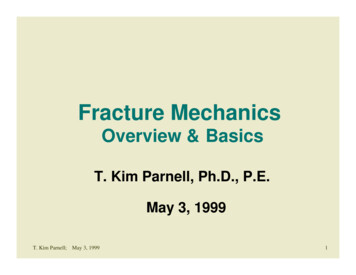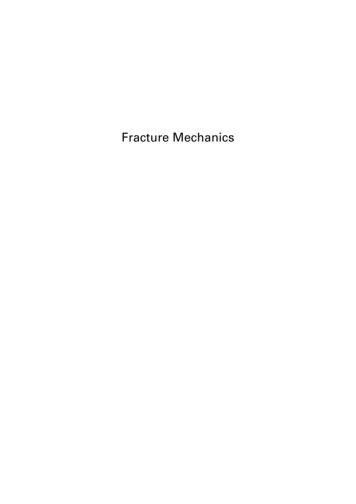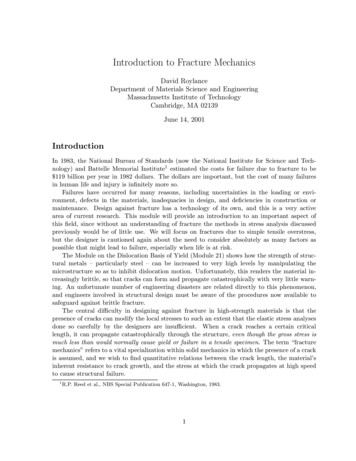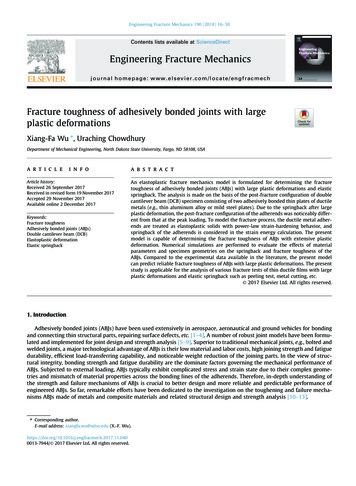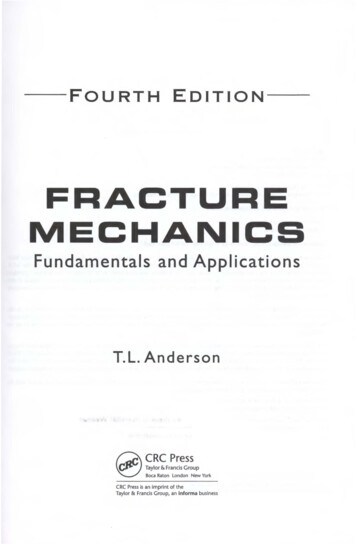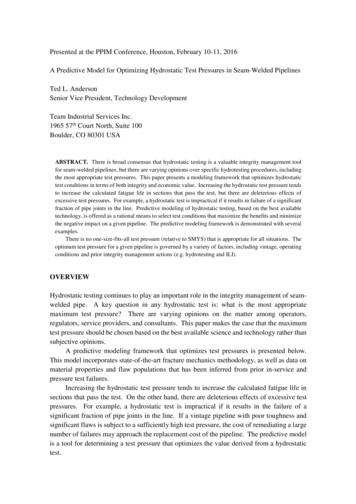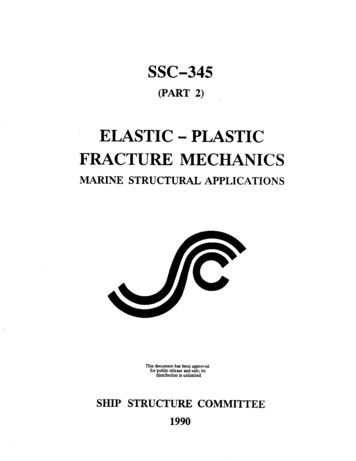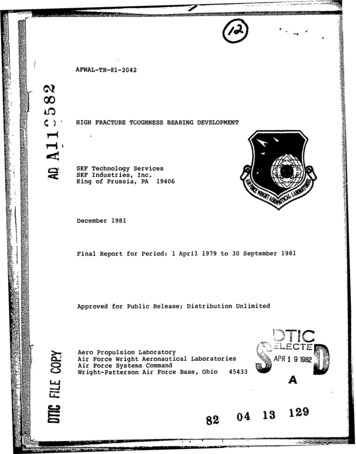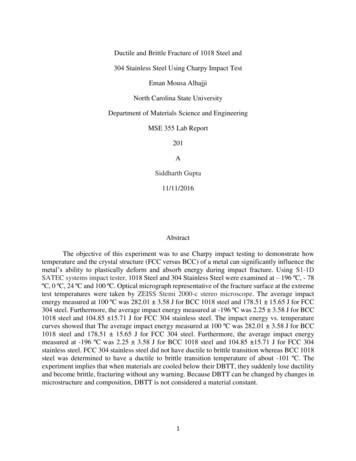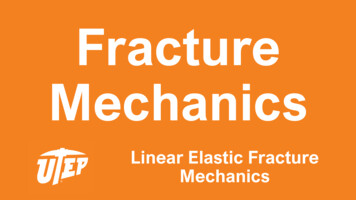
Transcription
FractureMechanicsLinear Elastic FractureMechanics
Linear Elastic FractureMechanicsPresented byCalvin M. Stewart, PhDMECH 5390-6390Fall 2020
Outline Crack Tip Singularity Williams Solution Westergaard Stress Function Stress Intensity FactorHarold Malcolm Westergaard (1888-1950)
Crack Tip Singularity
Crack Tip Singularity Elastic solutions for stress concentraions, such as Inglis solution forthe elliptical hole, can provide useful information about the stressesat a flaw. An interesting phenomenon is observed when those features aresharpened into cracks. A EllipseLine discontinuity (crack) As the vertical thickness, b reduces to zero, the stresses at the cracktip become infinite!!!
Crack Tip Singularity It turns out that the strength-of-materials assumption, where fractureis controlled by the stress at the tip of the crack, is not a valid failuremodel in general. Any hairline flaw on a structure would result in instant failure. When there is a significant stress gradient in the structure, failure isgenerally not governed by a single high-stress point. An alternative method is needed.
Crack Tip Singularity Linear Elastic Fracture Mechanics can be divided into two approaches. Fracture Energy approach Stress Intensity Factor approach Both approaches are a part of LEFM. In this Lecture, we will focus on the Stress Intensity Factor approach.
Williams SolutionDerivation from Anderson 2nd Edition, Appendix 2A
Williams Solution For certain cracked configurations, it is possibleto derive closed-form expressions for thestresses in the body, assuming isotropic linearelastic material behavior. Westergaard, Irwin, Sneddon, and Williamswere among the first to publish such solutions.In cylindrical coordinates, the Stress Field atthe crack tip can be defined aswhere σij is the stress tensor; r and θ are the radius and angle from the crack tip;k is a constant; and fij is a dimensionless function of in the leading term.
Williams Solution Williams (1950’s) developed an approach for analyzing the generalsolution to two singular problems: plate corner and sharp crack. Key Assumptions: In-Plane Loading, Elastic, Isotropic ConditionsPlate corner with included angleSpecial case of a Sharp Crack
Williams Solution: Sharp Crack Williams postulated a form of the Airy Stress Function ( r , * ) g ( r , ) f ( * , )g ( r , ) r 1f ( * , ) . Such that is determinedas a part of thesolution
Williams Solution: Sharp Crack To Satisfy Equilibrium, in cylindrical coordinates where the primes ‘ denote derivatives with respect to * Traction free fractures surfaces produce ( 0 ) ( 2 ) 0 r ( 0 ) r ( 2 ) 0
Williams Solution: Sharp Crack For the displacements in all parts of the body to be finite, 0 The boundary conditions can only be satisfied whensin ( 2 ) 0 Thus, As such, we can express the components of as
Williams Solution: Sharp Crack is a function that depends on F and its derivatives. When r is small,the first term dominates the solution and higher order terms areneligible, using the additional B.C.’s gives
Williams Solution: Sharp CrackReplacing * givesThe stresses become,
Williams Solution: Sharp Crack The terms si and ti are defined. si are multiplied by cosine functions Symmetric ti are multiplied by sine functions Antisymmetric Symmetric Bending and/or Tension ti 0 Mode I Antisymmetric Pure Shear si 0 Mode II Thus,
Williams Solution: Sharp CrackCrack Tip Stress FieldsMode I:Mode II:Note: This is the solution if we neglect the higher order terms.
Williams Solution: Sharp CrackThe Solution can be converted from Cylindrical to Cartesian coordinatesMode IMode IIK II sin 2 r 2 K yz II cos 2 r 2 xz
Westergaard Stress Function
Westergaard Stress Function Westergaard showed that a limited class of problems can be solved byintroducing a complex stress function Z(z) where The Westergaard stress function is related to Airy stress function as where the base represents integration such that
Westergaard Stress Function Remember from Airy Stress Functions that Thus,
Westergaard Example Derive the crack tip stress field for theinfinite plate loaded in equi-biaxialtension Assume the Origin is at the center ofthe crack. The Westergaard Stress function isgiven as remote stressa half crack length
Westergaard Example The boundary conditions are y 0 y x y a x ay 0x y x a(Crack Faces are Traction Free)(Remote Conditions)y 0(Crack Tip Singularity)
Westergaard ExampleNote: Check BC’s 1)y 0 z x Z ( z ) Z ( x) When, a x a x 2 a 2 0 Then,Z ( z) xx2 a2 Re Z ( z ) 0 x xi a2 x2 i a2 x2 i xa2 x2 y Re Z ( z ) y Im Z ( z ) 0 1 i 2 ii i
Westergaard Example Check BC’s 2)x y Then,Z ( z) 1 az x2 y 2 2(All Real) z2 x Re Z ( z ) y Im Z ( z ) Re Z ( z ) y Re Z ( z ) y Im Z ( z ) Re Z ( z ) Note:1 1 1
Westergaard Example Check BC’s 3)x a Then,&y 0lim Z ( z ) z a lim Z ( z ) z a z a a (a 2)(a 2 a2 a ) a2 y Re Z ( z ) y Im Z ( z ) Re Z ( z )
Westergaard Example Mode I Stress Intensity Factor z aZ ( ) (a )(a )2Near the crack tip, a 2 ( a )2a 2 aExpression for KIn Polar Coordinates aa 12Z ( ) 22a 111 i i a a rei , Z ( ) r 2 e 2 e 222 r
Westergaard ExampleExpression for K111 i i a a rei , Z ( ) r 2 e 2 e 222 r The factor was introduced to make theformulation conform to current notation. Itwas also used here because it appears in theenergy release rate defined with K. Using,rei r cos ( ) i sin ( ) The Stress components of the equi-biaxiallyloaded plate can be found as
Westergaard ExampleKI Re Z ( z ) cos 2 r 2 KI 3 Re Z ( z ) cos 2r 2 r 2 KI 3 y Im Z ( z ) r sin ( )sin 2r 2 r 2Thus,KI 3 sincos sin 2 r 2 2 2 KI 3 cos 1 sin sin 2 r 2 2 2 KI 3 y cos 1 sin sin 2 r 2 2 2 x xy KI 3 sin cos cos 2 r 2 2 2 Note: For Non-equi-biaxial loading. Where the verticaland horizontal loads are different. We must superimposean opposing load, in the axial load in the x-axis, as followsKI 3 x cos 1 sin sin 2 r 2 2 2 ox
Stress Intensity Factor
Stress Intensity Factor In the stress field equations derived thus far, a term k, also shown asKI, KII, and/or KIII, keeps appearing.This parameter, called the StressIntensity Factor, K remains finiteeven when the crack is sharp.This is a useful parameter inLEFM.
Stress Intensity Factor In the next lecture, we will explore the usefulness of the StressIntensity Factor. It will be shown that K is a fracture resistance parameter that can beevaluated against a material property KIC to determine if fracture hasoccured.
Summary Several researchers proposed solutions to the Stress Field in the vicinity of acrack. Any Stress field solution must satisfy both equilibrium and compatibility. This canbe achieved by proposing a function Airy Stress function, φ(x,y) that simplifies tothe Biharmonic equation. 4 0 Considerable mathematical effort must be expended to derive these equations. The Stress Intensity Factor, K remains finite. It will be shown that K is a fracture resistance parameter that can be evaluatedagainst a material property KIC to determine if fracture has occured.
Homework 4 Verify that ANSYS Student Edition has been successfully installed onyour computer. Perform literature review and investigate the Fracture Mechanicstools that are available inside of ANSYS. Write a brief 500-wordsummary of the tools that are available. Collect and provide links toyour references including but not limited to: technical reports, usermanuals, guides, tutorials, and instructional videos.
References Janssen, M., Zuidema, J., and Wanhill, R., 2005, Fracture Mechanics, 2ndEdition, Spon Press Anderson, T. L., 2005, Fracture Mechanics: Fundamentals and Applications,CRC Press. Sanford, R.J., Principles of Fracture Mechanics, Prentice Hall Hertzberg, R. W., Vinci, R. P., and Hertzberg, J. L., Deformation and FractureMechanics of Engineering Materials, 5th Edition, Wiley. https://www.fracturemechanics.org/
Calvin M. StewartAssociate ProfessorDepartment of Mechanical EngineeringCONTACTINFORMATIONThe University of Texas at El Paso500 W. University Ave, Suite A126, ElPaso, TX 79968-0521Ph: t/
Anderson, T. L., 2005, Fracture Mechanics: Fundamentals and Applications, CRC Press. Sanford, R.J., Principles of Fracture Mechanics, Prentice Hall Hertzberg, R. W., Vinci, R. P., and Hertzberg, J. L., Deformation and Fracture Mechanics of Engineering Materials, 5th Edition, Wiley. https://www.fracturemechanics.org/

